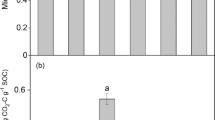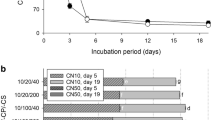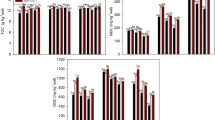Abstract
The objective of the present study was to determine whether substrate-induced priming effects in soils are sensitive to increasing levels of Cu and Zn. Soils were collected from ten plots of two Australian field experiments (Spalding and Avon) where increasing amounts of Cu or Zn had been added 2 years prior to sampling, reaching maximum values of 5,880 mg kg−1 for Cu and 7,400 mg kg−1 for Zn. In a 21-day incubation experiment, the effect of uniformly 14C-labeled fructose and alanine on the mineralization of the soil organic carbon (SOC) was investigated. With increasing heavy metal content, the initial peak of soil respiration after substrate addition was retarded, indicating that the microorganisms utilizing these substrates were inhibited in soils highly contaminated with heavy metals. Both substrates strongly changed the mineralization of the soil organic matter (SOM), i.e., priming effects were induced. In the soil samples with high Cu concentrations from Spalding, fructose induced a stronger additional mineralization of the SOC than in the lower contaminated samples. In the samples with the highest Zn contamination level, negative priming effects, i.e., a reduced mineralization of SOM, were observed. In contrast, heavy metal effects in the Avon soil (pH 7.6) were less pronounced since substrate mineralization and priming effects were not directly related to the increasing heavy metal content. Apart from direct toxic heavy metal effects, the tested microbial activity parameters were also indirectly affected through the toxic heavy metal effects on plant growth. At the highest heavy metal contaminations, no fresh biomass inputs occurred during the past 2 years so that microorganisms in these soils were highly substrate-limited. As a consequence, complex interactions between different levels of heavy metal contamination, the microbial activity, and the input of SOC via plant biomass have to be considered.



Similar content being viewed by others
References
Bell JM, Smith JL, Bailey VL, Bolton H (2003) Priming effect and C storage in semi-arid no-till spring crop rotations. Biol Fertil Soils 37:237–244
Blagodatskaya EV, Kuzyakov Y (2008) Mechanisms of real and apparent priming effects and their dependence on soil microbial biomass and community structure: critical review. Biol Fertil Soils 45:115–131
Brookes PC (1995) The use of microbial parameters in monitoring soil pollution by heavy metals. Biol Fertil Soils 19:269–279
Broos K, Mertens J, Smolders E (2005) Toxicity of heavy metals in soil assessed with various soil microbial and plant growth assays: a comparative study. Environ Toxicol Chem 24:634–640
Broos K, Macdonald LM, Warne MSJ, Heemsbergen DA (2007a) Limitations of soil microbial biomass carbon as an indicator of soil pollution in the field. Soil Biol Biochem 39:2693–2695
Broos K, Warne MSJ, Heemsbergen DA, Stevens D, Barnes MB, Correll RL, McLaughlin MJ (2007b) Soil factors controlling the toxicity of copper and zinc to microbial processes in Australian soils. Environ Toxicol Chem 26:583–590
Chander K, Brookes PC (1991) Microbial biomass dynamics during the decomposition of glucose and maize in metal-contaminated and non-contaminated soils. Soil Biol Biochem 23:917–925
Chander K, Joergensen RG (2001) Decomposition of 14C glucose in two soils with different amounts of heavy metal contamination. Soil Biol Biochem 33:1811–1816
Coleman DC, Corbin FT (1991) Introduction and ordinary counting as currently used. In: Coleman DC, Corbin FT (eds) Carbon isotope techniques. Academic, San Diego, pp 3–9
Dalenberg JW, Jager G (1989) Priming effect of some organic additions to 14C-labelled soil. Soil Biol Biochem 21:443–448
De Nobili M, Contin M, Mondini C, Brookes PC (2001) Soil microbial biomass is triggered into activity by trace amounts of substrate. Soil Biol Biochem 33:1163–1170
Doelman P, Haanstra L (1984) Short-term and long-term effects of cadmium, chromium, copper, nickel, lead and zinc on soil microbial respiration in relation to abiotic soil factors. Plant Soil 79:317–327
Giller KE, Witter E, McGrath SP (1998) Toxicity of heavy metals to microorganisms and microbial processes in agricultural soils: a review. Soil Biol Biochem 30:1389–1414
Giller KE, Witter E, McGrath SP (2009) Heavy metals and soil microbes. Soil Biol Biochem 41:2031–2037
Hamer U, Marschner B (2005a) Priming effects in different soil types induced by fructose, alanine, oxalic acid and catechol additions. Soil Biol Biochem 37:445–454
Hamer U, Marschner B (2005b) Priming effects in soils after combined and repeated substrate additions. Geoderma 128:38–51
Heemsbergen DA, Warne MSJ, Broos K, Bell M, Nash D, McLaughlin MJ, Whatmuff MS, Barry G, Pritchard D, Penney N (2009) Application of phytotoxicity data to a new Australian soil quality guideline framework for biosolids. Sci Total Environ 407:2546–2556
Houba VJG, Temminghoff EJM, Gaikhorst GA, van Vark W (2000) Soil analysis procedures using 0.01 M calcium chloride as extraction reagent. Commun Soil Sci Plant Anal 31:1299–1396
Isbell RF (1996) The Australian soil classification. CSIRO Publishing, Collingwood
IUSS Working Group WRB (2006) World Reference Base for Soil Resources 2006. World Soil Resources Report No. 103. FAO, Rome
Jüschke E (2009) Effluent irrigation and agricultural soils—effects on the dynamics of organic carbon and microbial activity in agricultural soils in Israel. Verlag Dr Kovač, Hamburg
Kuzyakov Y, Bol R (2006) Sources and mechanisms of priming effect induced in two grassland soils amended with slurry and sugar. Soil Biol Biochem 38:747–758
Kuzyakov Y, Friedel JK, Stahr K (2000) Review of mechanisms and quantification of priming effects. Soil Biol Biochem 32:1485–1498
Leifeld J, Siebert S, Kögel-Knabner I (2002) Biological activity and organic matter mineralization of soils amended with biowaste composts. J Plant Nutr Soil Sci 165:151–159
Li Y-T, Rouland C, Benedetti M, F-b L, Pando A, Lavelle P, Dai J (2009) Microbial biomass, enzyme and mineralization activity in relation to soil organic C, N and P turnover influenced by acid metal stress. Soil Biol Biochem 41:969–977
Liang BC, Gregorich EG, MacKenzie AF (1999) Short-term mineralization of maize residues in soils as determined by carbon-13 natural abundance. Plant Soil 208:227–232
McGrath SP, Chaudri AM, Giller KE (1995) Long-term effects of metals in sewage sludge on soils, microorganisms and plants. J Ind Microbiol Biotechnol 14:94–104
McLaughlin MJ, Hamon RE, McLaren RG, Speir TW, Rogers SL (2000) Review: A bioavailability-based rationale for controlling metal and metalloid contamination of agricultural land in Australia and New Zealand. Aus J Soil Res 38:1037–1086
McLaughlin MJ, Whatmuff MS, Warne MSJ, Heemsbergen D, Barry G, Bell M, Pritchard D (2006) A field investigation of solubility and food chain accumulation of biosolid-cadmium across diverse soil types. Environ Chem 3:428–432
Nordgren A, Bååth E, Söderström B (1988) Evaluation of soil respiration characteristics to assess heavy metal effects on soil microorganisms using glutamic acid as a substrate. Soil Biol Biochem 20:949–954
Ohm H, Hamer U, Marschner B (2007) Priming effects in soil size fractions of a podzol Bs horizon after addition of fructose and alanine. J Plant Nutr Soil Sci 170:551–559
Smolders E, Buekers J, Oliver I, McLaughlin MJ (2004) Soil properties affecting toxicity of zinc to soil microbial properties in laboratory-spiked and field-contaminated soils. Environ Toxicol Chem 23:2633–2640
Verma L, Martin JP, Haider K (1975) Decomposition of carbon-14-labeled proteins, peptides, and amino acids; free and complexed with humic polymers. Soil Sci Soc Am J 39:279–284
Wakelin S, Chu G, Broos K, Clarke K, Liang Y, McLaughlin M (2010) Structural and functional response of soil microbiota to addition of plant substrate are moderated by soil Cu levels. Biol Fertil Soils 46:333–342
Warne MSJ, Heemsbergen D, McLaughlin M, Bell M, Broos K, Whatmuff M, Barry G, Nash D, Pritchard D, Penney N (2008a) Models for the field-based toxicity of copper and zinc salts to wheat in 11 Australian soils and comparison to laboratory-based models. Environ Pollut 156:707–714
Warne MSJ, Heemsbergen D, Stevens D, McLaughlin M, Cozens G, Whatmuff M, Broos K, Barry G, Bell M, Nash D, Pritchard D, Penney N (2008b) Modeling the toxicity of copper and zinc salts to wheat in 14 soils. Environ Toxicol Chem 27:786–792
Acknowledgments
The authors gratefully acknowledge the National Biosolids Research Program (NBRP) for providing the soil samples and data. This project was financially supported by the German Foundation of Research (DFG) within the priority programme 1090 “Soils as source and sink of CO2—mechanisms and regulation of organic matter stabilisation in soils”.
Author information
Authors and Affiliations
Corresponding author
Rights and permissions
About this article
Cite this article
Ohm, H., Marschner, B. & Broos, K. Respiration and priming effects after fructose and alanine additions in two copper- and zinc-contaminated Australian soils. Biol Fertil Soils 47, 523–532 (2011). https://doi.org/10.1007/s00374-011-0566-0
Received:
Revised:
Accepted:
Published:
Issue Date:
DOI: https://doi.org/10.1007/s00374-011-0566-0




